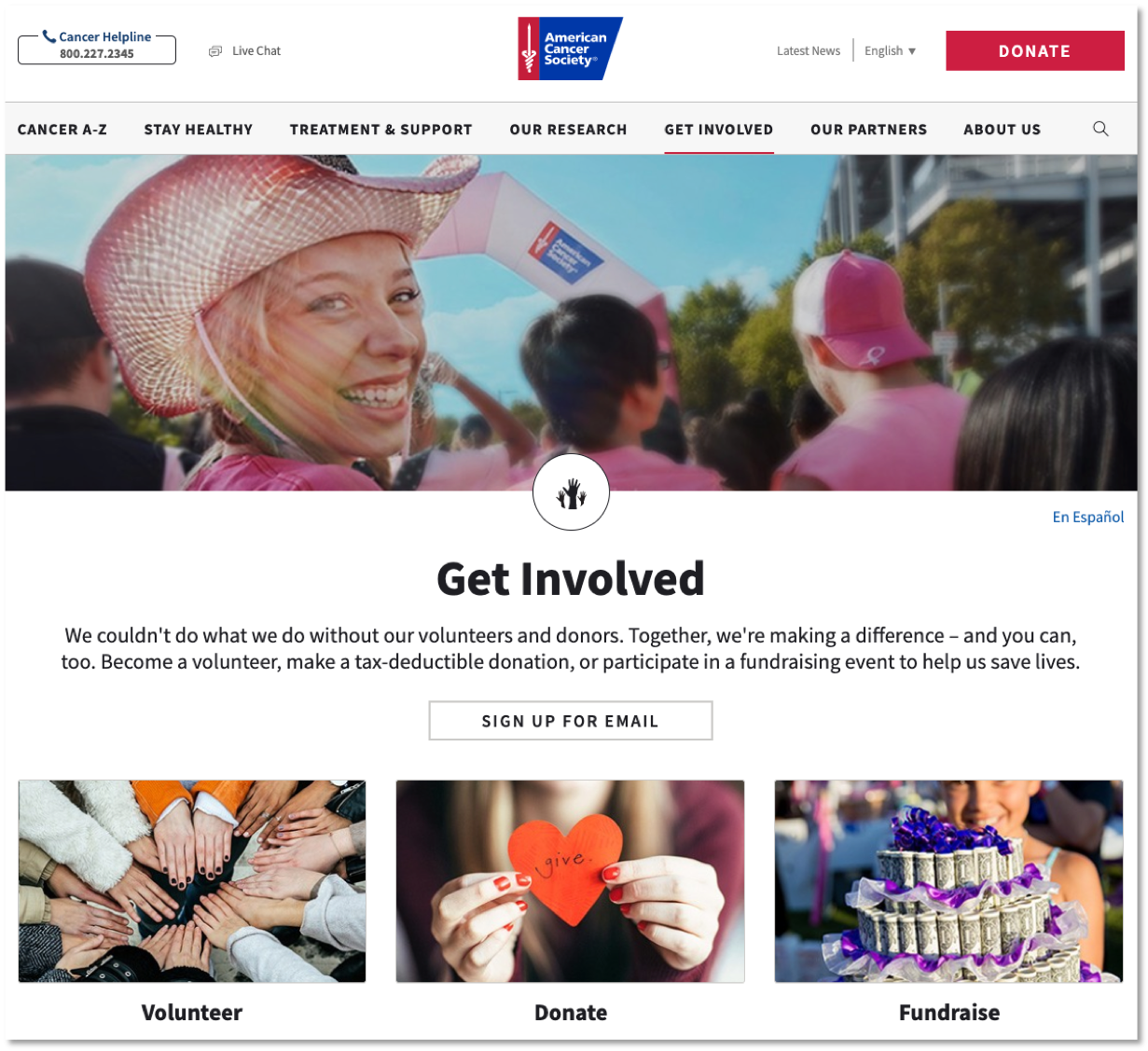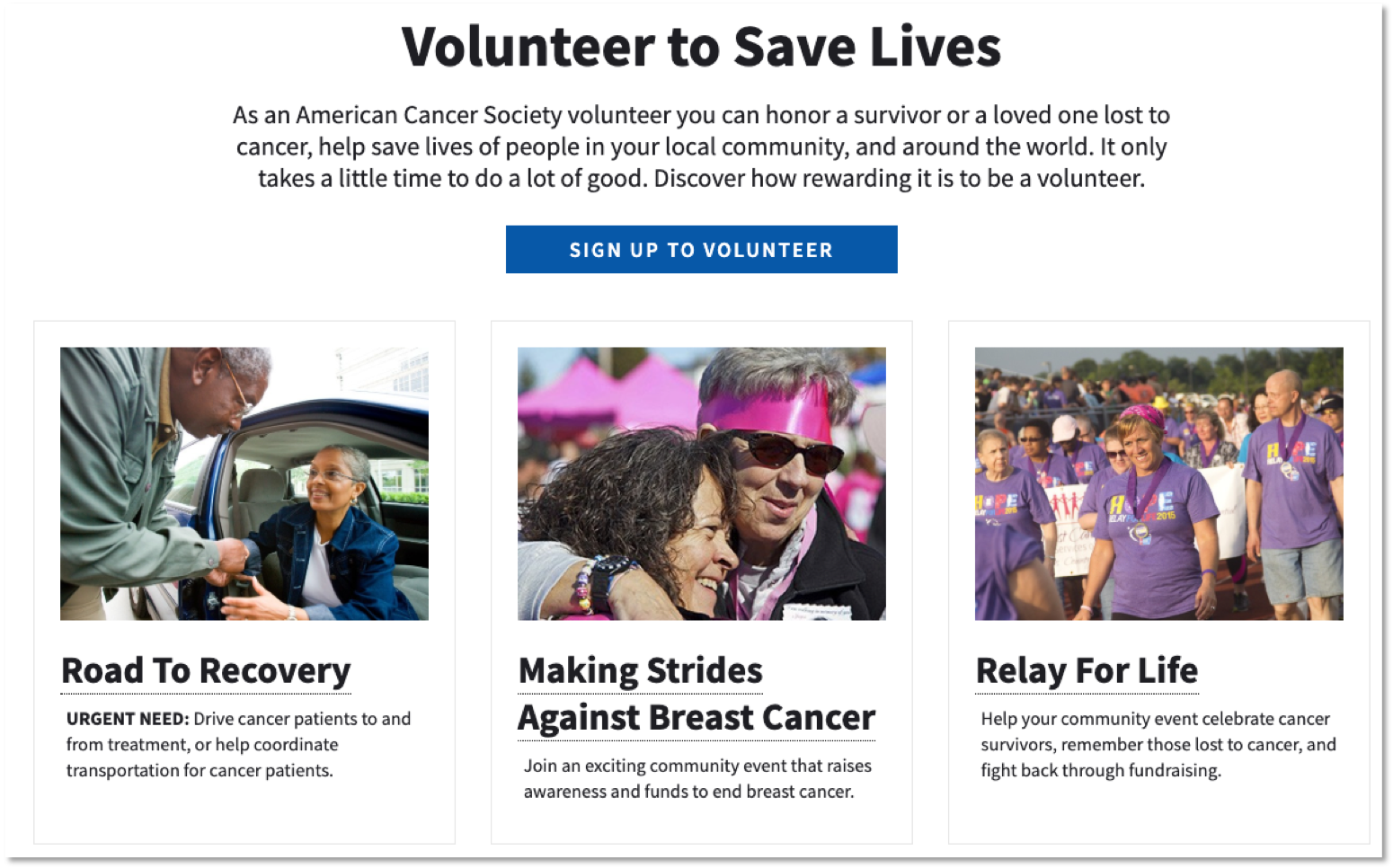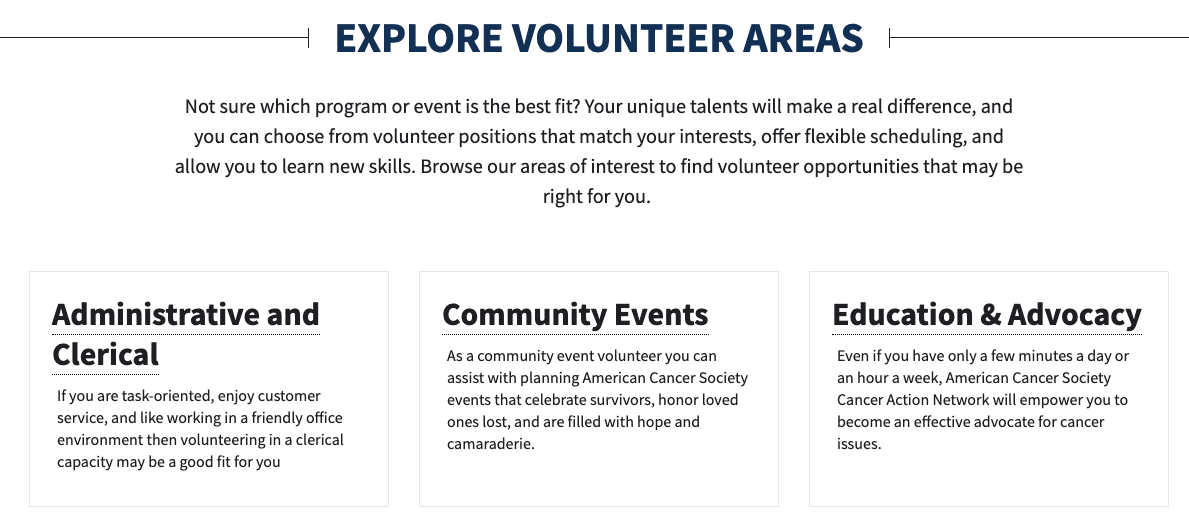
3 Ironclad Ways to Better Recruit Volunteers Online
If you want to grow volunteer participation at your nonprofit and are seeking new ideas for recruiting volunteers online, you’re on the right track.
Now, more than ever, recruiting volunteers online is your best bet for connecting with potential supporters. Research now shows that Americans spend a lot of time online.
So, why not meet volunteers where they’re at?
Online Participation is Booming
Online participation is booming and will be the key to any future volunteer recruitment success.
According to the Pew Research Center, 90% of all Americans go online. Of these, 81% do so on a daily basis. That figure includes the 28% who go online constantly, 45% who say they go online several times a day, and 9% who go online about once a day. Some 8% go online several times a week or less often.
The breakdown of percentage of US adults who use the internet by age is as follows:
- 18-29 year olds: 100%
- 30-49 year olds: 97%
- 50-64 year olds: 88%
- 65+ year olds: 75%
What’s more, the vast majority of Americans (81%) now own a smartphone, up from 35% in the Pew Research Center’s first survey of smartphone ownership in 2011. And, the share of people who use their smartphones as the primary way they access the internet is growing, as well. 17% of Americans are “smartphone only” internet users.
In addition, most American’s use at least one social media platform. Facebook and YouTube are by far the most popular, with 68% of US adults using Facebook and 73% using YouTube. And, many social media users make visits part of their daily routine. 74% of Facebook users, 63% of Instagram users, and 51% of YouTube viewers visit these sites at least once a day.
Times certainly have changed.
Twenty years ago, nearly half (48%) of American adults did not use the internet. Now, only 10% of the population do not use the internet at all.
 Non-adoption correlates with a number of demographic variables including age, education, household income, and community. Despite ongoing government and social service programs to encourage internet adoption, the size of this group remains unchanged over recent years.
Non-adoption correlates with a number of demographic variables including age, education, household income, and community. Despite ongoing government and social service programs to encourage internet adoption, the size of this group remains unchanged over recent years.
The data tells the story.
Most people are using the internet and social media as a part of their daily lives. So, it makes sense that leaders of volunteers meet future volunteers where they’re at – online. Even more specifically, nonprofits should work hard to make it easy for volunteers to find their opportunities on their smart phones.
Below are three simple, but powerful recommendations for increasing the effectiveness of your digital presence online by optimizing your website and creating opportunities to nurture your audience before making the ask to volunteer.
If you take the steps needed to develop a more purposeful strategy to recruiting volunteers online, your agency will benefit from more traffic to your volunteer recruitment appeals, and you will enjoy better follow through by prospective supporters.
#1: Map Out Your Ideal Volunteer Journey
First things first – Is your website volunteer friendly?
When volunteers are searching online and arrive at your website, is it clear what path they need to take to join? Are you aware of the path you’d like them to take?
The online space is noisy, and your readers are distracted. So, setting up a logical progression of “micro-conversions” – or tiny steps – from start to finish can help them complete the online volunteer recruitment process.
The most obvious – and powerful – journey is from your home page to your volunteer application or interest form. Most online visitors likely visit your home page before exploring further, so making it clear that a) volunteer opportunities are available and b) there is a clear and simple process to get started can do wonders for the number of people who apply.
A Great Volunteer Journey Example
The American Cancer Society does a great job of this in the Get Involved section of their website. They offer three clear options – Volunteer, Donate, or Fundraise – so visitors can quickly access the information that makes most sense for their direct interests. They also include a compelling “hero” Image at the top of the page showing the context and making it easy for people to visualize themselves enjoying the benefits of volunteering.

On their volunteer page, they continue to help visitors find their way. At the top of the page, they state their value proposition (or what volunteers will help achieve) — “Volunteer to Save Lives.” In the sub-header, they clearly stating the benefits of volunteering and the fact that expectations are not overly onerous – “It only takes a little time to do a lot of good.”
In addition, they include visual tiles of the kinds of volunteer programs that are available with short descriptions and those with an “Urgent Need” placed first.

Further down the page, they list a variety of volunteer roles, so users can filter opportunities by skill area from “Administrative and Clerical” to “Opportunities for Organization.” And, at the bottom of the page, they link to the ways they support volunteers in service.

When visitors click on specific volunteer program or department, they are then sent to a specific landing page that described that volunteer role. These online volunteer position descriptions succinctly describe why the role is important, what volunteers need to be successful, and how interested people can get started.

Each page includes a single, clear “Volunteer Now” call to action button that links to an interest form. Rather than requiring too much, only contact information and an indication of types of programs the volunteer might be interested in are required. Finally, an expected time frame for follow up is provided.
What makes this site so effective is its logical progression of steps. Volunteers go from home page, to the get involved page, to the volunteer page, to the volunteer roles, to the sign-up form.
There is little extraneous information to distract the user from this path. And, yet, there is plenty of well-organized information provided so visitors can browse and educate themselves on what’s available before completing the interest form.
This also helps the user pre-qualify themselves before making a commitment, thus saving time for both the volunteer and volunteer manager.
Idea #2: Build Your Newsletter List
While we often think of creating and sending newsletters to our existing supporters, why not use them in recruiting volunteers online to cultivate and engage new followers and high potential volunteers?
Newsletters are a great way to educate your audience about your organization’s mission, its needs, and its achievements. If you regularly feature volunteer stories, quotes, and testimonials about their service, you’re also sharing a powerful dose of social proof that encourage readers to get involved, too.
Make sure you make it super easy to find and sign up for your newsletter from your website and produce it on a regularly occurring basis, so your audience knows what to expect and builds trust in your process and consistency.
Your newsletters must also be engaging enough to be opened and read on a regular basis. When you set out to write, focus your copywriting on what you want readers to think, feel, and do with your information.
Focused Volunteer Newsletters: Questions to Ask

Also, here are some tips for better newsletters:
- Keep it to a single compact column – It’s much easier to read on a phone.
- Ditch the PDF & embed them in emails – Don’t ask people to download PDFs; let them read your newsletter on their phone.
- Feature stories of transformation not tragedy – Keep it upbeat! Enthusiasm is highly under-rated and positive messages are most often shared.
- Include buttons for important Calls to Action (CTAs) – If you need someone to do something, make a button and link directly to the form.
- Include photos of your volunteer fans – Social cues are more powerful with photos, they increase the perceived truthfulness, and people will share them.
- Increase the frequency if too long – Send at least monthly, but more often if they are too packed with content; keep to no more than 3-4 items per newsletters.
- Link to your website for better SEO (search engine optimization) – The more traffic you drive to your volunteer recruitment web pages, the more often it will come up at the top of the Google search when potential volunteers are searching of opportunities.
- Coordinate timing with other emails – Don’t send them the same day or even the same week if you are making asks for both volunteering and financial contributions.
Idea #3: Create a Freebie Opt-In
Similar to newsletters, you can create freebie downloads to begin building relationships, and warm up your potential supporters, both volunteers and donors alike.
Consider sharing special knowledge or insights about your topic area:
- How your mission impacts others
- Newsworthy items or trends
- Industry research about your cause
- Info that helps your audience do X, Y, Z
- How to help a friend or family member
- How you can feel good about taking action
- Make a difference by taking these small steps
- Save time by getting prepared now
- Have fun!
Consider: What does your agency already share with your supporters (donors or volunteers)? Would these items be of interest to prospective volunteers, too?
You can drive your audience to your freebie through social media, your newsletter, your blog, and emails to your audience. You can even let people know about it in paper brochures and fliers.
Ideas for Freebies

Using the Right Opt-In From
Make sure to ask for your audience member’s first name and email using an opt in form so you can build your email list and communicate with them about other freebies and opportunities to get involved.
And, pay close attention to the form you use.
Opt-in forms come in many shapes and sizes. They can pop up, be placed inline after a blog post, be a floating bar at the top of the page, take up the whole page, or be a lightbox that is partially translucent and appears over the page. Talk to you web designer to find out what might work best on your website.
Here’s an example of an opt in we offer on our VolunteerPro website, embedded in the Volunteer Appreciation chapter of our Essential Guide to Managing Volunteers at Your Nonprofit. This type of opt-in is known as a “two-step” opt in (not to be confused with a double opt-in, which is also important).
This strategy has been shown to inspire higher conversion rates because it reduces friction on the part of the reader.
Two Step Opt-in: Step One
In the first step, we describe what the visitor will get in clear terms in the header. In the sub-header we describe the benefit – saving them time with quick, creative ideas.

In the second step, the form to enter their first name and email appear. We keep it simple, by asking for the minimum amount of information necessary.
By design, this works well because the form is launched after a user-driven request and because it follows our natural urge to be consistent with previous actions, or the consistency principle of persuasion.
The visitor clicks on the link to subscribe with the intent to do exactly that, subscribe. The click demonstrates the reaction to a modest request, creating a level of commitment that makes the visitor more likely to complete the form (a larger request) when it’s presented.
We also reinforce the value of the opt in by sharing the ultimate benefit of using our tool – to keep volunteers coming back – in the headline. And, we share a little bit more about what’s inside – our four-part formula for better thank you letters.
Two Step Opt-in: Step Two

When recruiting volunteers online, you can use the same strategy of free content that is accessed through opt ins to build a list of high potential supporters.
Once they’ve joined your list, be sure to share concrete information of value about your cause and how you are making a difference. Also, share inspirational stories of change and make sure you are helping them learn along the way.
By the time you are recruiting for your next volunteer orientation, you’ll have a whole new group of followers who already know something about you and will be more likely to respond to your calls to action.
Consider: What information would your audience want to know about your cause on an ongoing basis? What would they find the most valuable?
So, next time you think about how to improve your volunteer recruitment results, look to your own website.
Ask yourself — how can we build better pathways and engage with interested people before we ask them to support us. How can we cultivate trust and concern for our missions though regular communication and education?
What’s Your Favorite Idea for Recruiting Volunteers Online?
Which of these three ideas for recruiting volunteers online are your favorite? Have you tried any of these before? How did it go?





